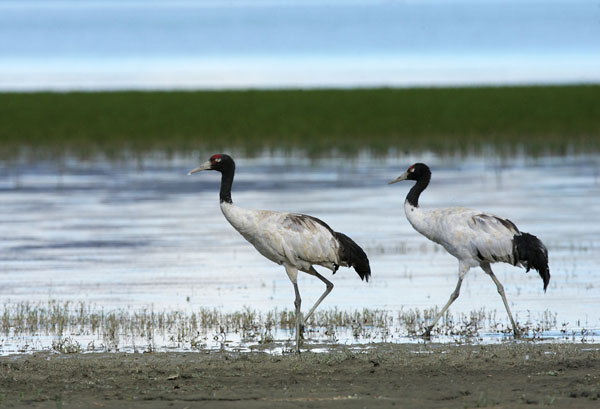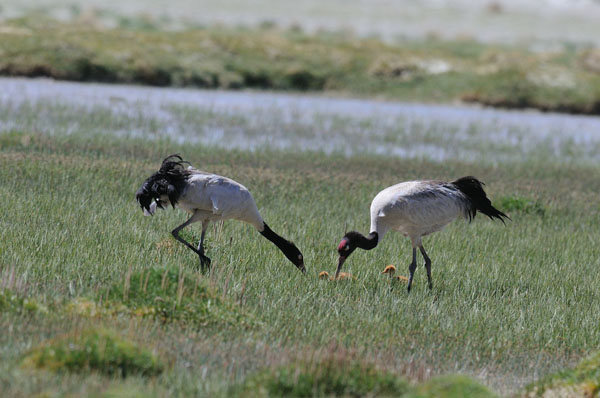Grus nigricollis
IUCN
LCBasic Information
Scientific classification
- name:Grus nigricollis
- Scientific Name:Grus nigricollis,Black-necked Crane, Tibetan Crane, Grulla Cuellinegra,,Tibetan crane, wild goose, black goose, dry goose
- Outline:Wading birds
- Family:Gruiformes Gruiformes Grus
Vital signs
- length:110-120cm
- Weight:4-6kg
- lifetime:5years
Feature
The only crane in the world that lives and breeds on the plateau. It is known as the "bird panda"
Distribution and Habitat
It is a species endemic to China, distributed in the Qinghai-Tibet Plateau and the Yunnan-Guizhou Plateau, including Tibet, Qinghai, western Sichuan and southern Gansu. It mainly winters in the middle reaches of the Yarlung Zangbo River in Tibet, Caohai in Guizhou, Zhaotong in Yunnan and other places. A small number of them are found abroad in Bhutan, northeastern India and northern Indochina.
It mainly inhabits plateaus, meadows, swamps and reed swamps at an altitude of 2500-5000 meters, as well as lakeside meadow swamps and river valley swamps. It is a crane that lives in plateau freshwater wetlands and is the only crane in the world that grows and breeds on the plateau.
Appearance
The neck and legs are very long, the feathers are grayish white, the body is tall, the head, throat and neck are black, and there is only a white patch extending from under the eye to behind the eye. The top of the head is red, and the tail, primary flight feathers and tertiary flight feathers are black. The head and front of the neck of the young bird are gray, and the face is light. The iris is yellow, the beak is gray or green, and the feet are black.
Details
Black-necked cranes are large flying wading birds. Except for the breeding season, they often move in pairs, individuals or family groups. In other seasons, they move in groups, especially in winter in wintering grounds, often forming large groups of dozens of individuals. During the wintering, they form larger groups, bringing their newly grown young birds with other families to form large groups of more than a dozen or even forty or fifty individuals. When flying long distances, they form neat teams in the shape of "I", "V" or "人", flying over mountains and ridges to reach places with mild climates to overwinter.

Its wintering grounds are relatively concentrated than its breeding grounds, mainly in the Caohai in Weining, Guizhou, Zhaotong, Huize, Yongshan, Qiaojia in northeastern Yunnan, Zhongdian, Lijiang and Ninglang in the northwest, and the swamps, wetlands and rivers in Lazi, Xietongmen, Shigatse, Zhanangnaidong and other places in Tibet. Due to the superior natural conditions and abundant food in these places, there are many black-necked cranes that come here to winter every year, accompanied by thousands of grey cranes and many other waterfowl species such as geese and ducks. When they first arrive at their wintering grounds, black-necked cranes are very timid and very alert. They hover in the air until they think they are safe and then slowly descend. After arriving at their destination, they begin to separate into groups and pair up, and then move in pairs.
Black-necked cranes are omnivorous, feeding on leaves, rhizomes, thorny thorns, tubers, algae, corn, and sand grains of plants. They also eat insects, fish, frogs, and crop seeds left in farmland. During the wintering period, they fly to swamps or sunny hillsides to forage around 7 a.m., and sometimes they go to harvested farmland to dig for potatoes, barley, buckwheat, oats, radishes, and grass roots left behind. When they dig for food, they rarely use their feet, but use their sharp beaks to catch animals in shallow water or dig food from the soil. There are rarely large groups during the wintering period, and usually small groups of 3 to 5 individuals forage for food in a scattered manner. Sometimes they fly into the herds of cattle, live in harmony with them, and eat food or parasites in their feces. Black-necked cranes are very alert, and whenever someone approaches, they fly away.

Black-necked cranes fly to their breeding grounds from the end of March to the beginning of April every year, choose a mate and mate, and then build nests in grass mounds, reeds or on the ground surrounded by water.
Tibetan people believe in Buddhism and love black-necked cranes very much, calling them "immortal cranes", "divine birds" and "auspicious birds".
The Chinese people have deep feelings for the black-necked crane, which is commonly known as "Qingzhuang", "Chongchong", "Gan'e", etc. In Tibetan, it is called "Gosedarizi", which means "horse herder", which means noble, pure and authoritative. Tibetan compatriots not only regard it as a "sacred bird", predict weather changes according to its calls, but also regard it as a "magic doctor". When someone has a fracture, they draw a black circle on the eggs in its nest, so that the female bird mistakenly thinks that the egg is about to crack, and will bring a "bone-setting stone" from a distance and put it in the nest to prevent the eggshell from cracking. People can secretly take this "bone-setting stone" away to cure the fracture.








